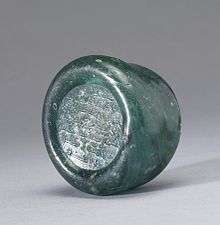Coin weights

Coin weights are weights which were designed to weigh coins in order to assure their quality.[1]
The usage of coin weights, especially glass ones, goes back to Ptolemaic and Byzantine times.[1] Coin weights were also known in Ancient China.[2]
In Islamic civilization, where they are called Sanadjāt, coin weights are said to have been introduced by a Jew named Sumair in 694.[1] Up to that point coins were only compared to coins of good quality.[1] Islamic coin weights were made of bronze, iron, and later glass (considered to be unalterable).[1] They bear inscriptions related to Islamic rulers and moneyers and are therefore valuable epigraphical objects.[1]
Coins weights were also known in the Carolingian Empire, where they were stamped with regular coin dyes to clarify their attribution.[3] Islamic coin weights were introduced to Great Britain in the 9-10th century CE through the Vikings.[4]
Notes
| Wikimedia Commons has media related to Coin weights. |